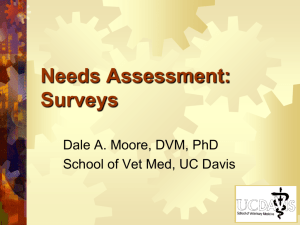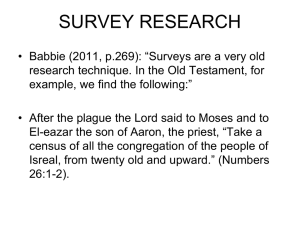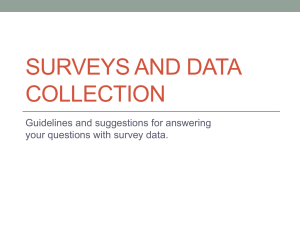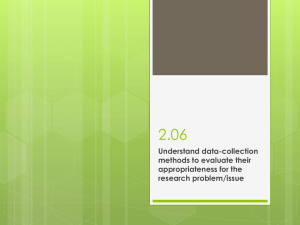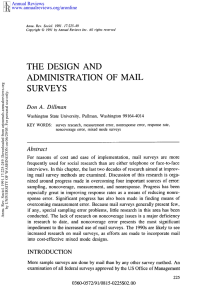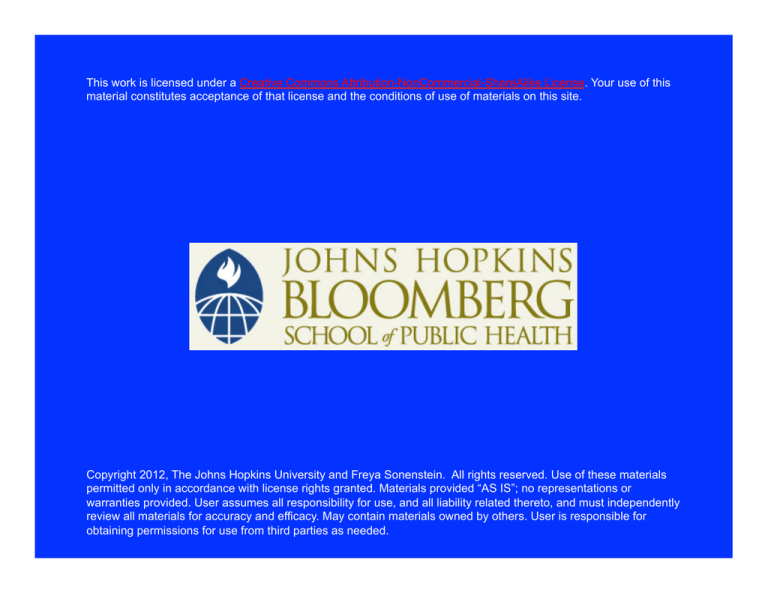
This work is licensed under a Creative Commons Attribution-NonCommercial-ShareAlike License. Your use of this
material constitutes acceptance of that license and the conditions of use of materials on this site.
Copyright 2012, The Johns Hopkins University and Freya Sonenstein. All rights reserved. Use of these materials
permitted only in accordance with license rights granted. Materials provided “AS IS”; no representations or
warranties provided. User assumes all responsibility for use, and all liability related thereto, and must independently
review all materials for accuracy and efficacy. May contain materials owned by others. User is responsible for
obtaining permissions for use from third parties as needed.
ISSUES IN SURVEY
RESEARCH
Mailed/Self-Administered Surveys
Web Surveys
Advantages of self administered
surveys compared to interviews
•
•
•
•
Lower costs
Lower staff requirements
Can survey complete listing of population
Able to locate respondents (particularly for
mail surveys most respondents have postal
addresses)
• Decrease in social desirability bias
Disadvantages
• Requires an up-to-date roster/list/enumeration of
units
• Lower response rates (see Dillman methods)
• No information or clues about non-respondents
• Types of questions constrained- complexity, open
ended
• No control of sequence or administration
• Literacy of respondents is an issue
• Full implementation requires time
Total Design Method (Dillman)
• Integrated approach to decrease errors in
representation and measurement
• Theory poses that recipient more likely to
respond if perceive:
– Low costs (ease and burden)
– High rewards (interest, enjoyment, altruism)
– Reason to trust (sponsorship, protections)
TDM Recommendations
• Format of instrument
– Attractive
– Booklet (maybe with a nice cover)– warning DO NOT
put questions on last back page—short 12 page
– Color of instrument
– Stamped return envelope
• Mailing
– Personalized--stamps
– Verify the list– spelling of names, etc.—can link with
prior notice
Instrument Construction
• Question order
– Most important to least important related to
topic of survey
– First question-neutral, applies to everyone,
interesting to everyone
– Questions grouped based on similar content
– Take into account cognitive ties that
respondents make between items
– Objectionable questions should be place after
less objectionable questions
• Format
– Lower case letters for questions, upper case
letters for answers
– Establish a vertical flow
– Provide navigational guides
– Directions for how to answer
– Booklet
– Thank you
Implementing Mail Surveys
• Follow- up sequence -Donald Dillman
– Postcard sent to everyone
– Three-weeks- letter and replacement questionnaire to
non-respondents
– Seven weeks-letter and replacement questionnaire sent
by certified mail
• Alternatives
– Telephone interview at 7 weeks
– Incentives
Web Surveys
Advantages
• Cost
• Specially suited to list samples with known
email addresses
• Less item non-response
• Applications available to customize
surveys-like survey monkey
Disadvantages
• How to avoid non-probability samples
• Difficult to distinguish between good and
bad survey responses
• Non-response can be black box
• Proliferation of surveys may result in
declining participation rates
• Variations in platforms, software among
respondents
Sources of Error with Web
• Coverage
– Not everyone in the target population is in the
frame population
– How to construct a frame population-all web
users
– Households have multiple email addresses
• Estimates of Web penetration-75%
Bias:Demographic Characteristics of
Users
• Households with incomes $75,000+ are 20
times more likely to access Internet than
those at lowest income levels
• African American and Hispanic households
2/5 as likely to access Internet than Whites
• Over represented groups are males, college
graduates, and adults 25 years of age and
younger
Types of Web Surveys
• Non Probability
– Polls, collective opinion of those who chose to
participate
– Unrestricted self-selected surveys- no access
restrictions and no or little control over multiple
completion e.g. magazine polls
– Volunteer panels of Internet users- large data
base is created of users, including selected
demographic characteristics- by invitation and
controlled through email and passwords
• Probability
– Intercept surveys-systematic sampling of every
nth visitor to a site to participate in the surveycustomer satisfaction
– List based samples of high coverage
populations-frame is build from known list i.e.
students, patients. Invitation is done through
email.
Non response error
– Denominator of those eligible to participate is not often
known
– When known, response rates tend to be lower than
mailed surveys -40%- electronic motivation is difficult
– Technical difficulties in interacting with Internet
survey- slow modem
– Concerns about confidentiality
• Measurement error
– Format, appearance of survey can vary from respondent
to respondent due to different browser settings ,
variations in hardware
– Little work on the optimal design for web surveysubgroups- teenage girls, seniors
– Computer literacy- designed for the least sophisticated
user
Dillman’s Principles for Email
Surveys
• Use a multiple contact strategy to elicit
response e.g. pre-notice email message
• Personalize email contacts
• Keep cover letter brief to get to first
question before having to scroll down a
page
• Include a replacement questionnaire with
reminder
Dillman’s Principles for Web
Surveys
• Introduce web questionnaire with a
welcome screen
• Provide a PIN number for limiting access
only to people in the sample
• Chose a first questions that is interesting to
most respondents, easily answered, and
fully visible on the welcome screen
Millar, M. M., Dillman, D. A. (2011). Improving response to web and mixed-mode surveys. Public Opinion Quarterly 75:249-269
Methods
• Conducted betwee 2/13/2009 and 4/22/2009
• Random sample of 2,800 undergrads at
Washington State University
• Utilized paper and online versions
• Web and paper questionnaires were
constructed similarly to minimized
differences
Results
Millar, M. M., Dillman, D. A. (2011). Improving response to web and mixed-mode surveys. Public Opinion Quarterly 75:249-269
Overall findings
• Simultaneous choice of modes does not
enhance response rate
• Combination of multiple mail & email
contacts works best
• Token cash in advance increases response
(can’t deliver this by email)

